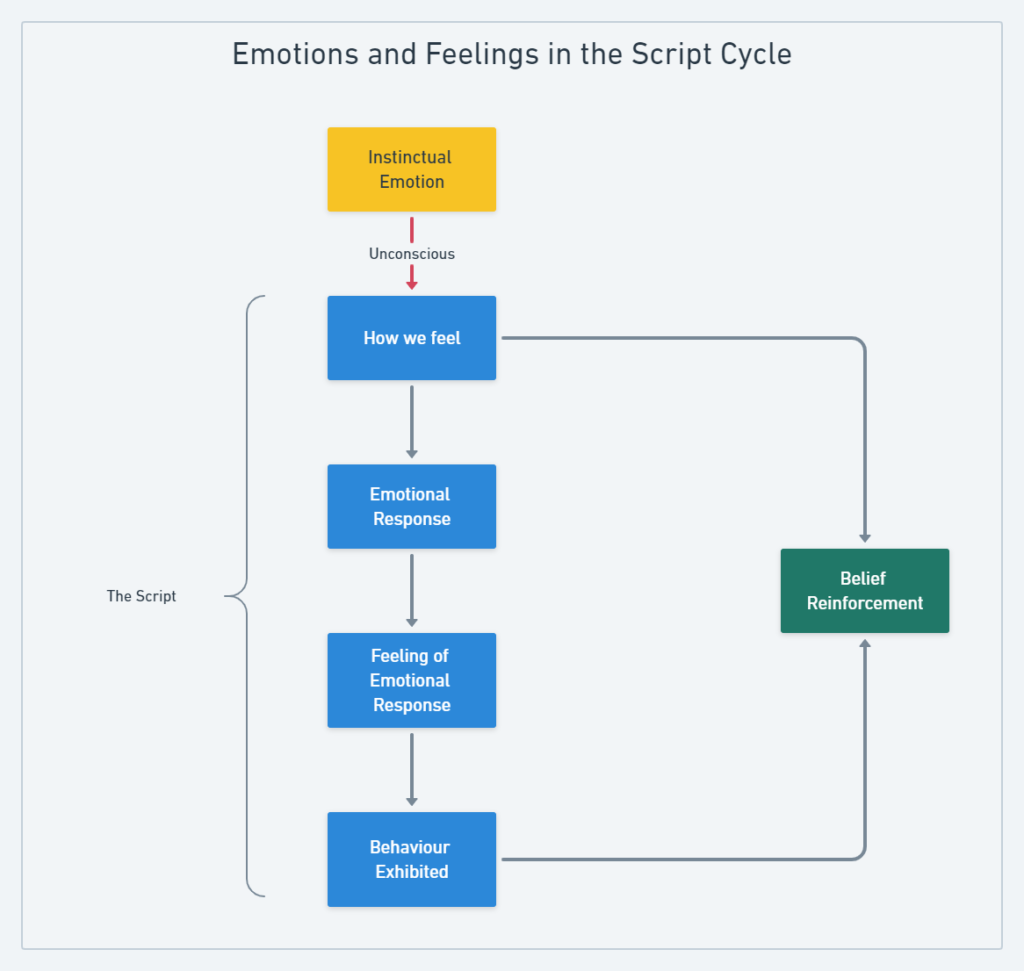Rewriting the Script – Breaking the Script (Part 1)
When thinking about scripts, it makes me think of trying to peg a bed sheet on to a washing line; all you need is one peg at each of two adjacent corners, and the sheet will hang there; blowing in the wind, flapping around, and filling up the garden of your mind.
In the case of your scripts, the two pegs that hold the sheet to the line are your emotions and your beliefs. Looking at scripts in more detail, this is how they work:

Our scripts are buried deep within our ego and it can be nigh on impossible to dig them fully out and rewrite them. What we can do though is learn to spot when they are happening, then follow the smoke to the emotion that triggered them and find the belief that is fuelling the fire.
Breaking the Cycle
Breaking the cycle is a multistage process that will take time to complete. You must be mentally calm and still, embodying I, to do it. Here is an overview of key stages that are involved:
- Be Curious:
- Identify: The behaviours you are displaying which you want to change
- Consider – How you feel when you are behaving that way. What emotion made you feel that way?
- Fear is at the root of most destructive scripts. Be honest with yourself and dig through your feelings to find the emotional to find the root.
- Accept Responsibility: Acknowledge the script exists and recognise that you have a choice about how you feel.
- Observe: Watch the script unfold and point at it. Become deeply aware and accept it in to your consciousness
- Be the change:
- First decide to choose not to engage any feeling in response to the instinctual emotion; you know it is coming so plan your first move – This is acceptance of your responsibility evidenced through action. You are preventing the trigger from being pulled. You are no longer feeding the bad wolf.
- Now you need to feed the good wolf. Write down a plan and then start to implement it:
- What are the beliefs the script is reinforcing?
- What new beliefs could counter and replace the old ones?
- How could you choose to feel about the instinctual emotion instead? Write down how you want to feel.
- What emotions, does feeling this way unlock?
- How do these emotions make you want to behave? Make sure this is how you want to choose to behave, if not, redefine your new beliefs until they do.
- Implementing the change: take this one step at a time and be kind to yourself. All that you can ask is that you make a tiny improvement each day, do not expect overnight success. Change is scary because growth hurts. We need to embrace the death of our old script and “me”, so that the “I” you want to be can be born. Without death there cannot be birth.
It is worth noting that your journey through this process may not be in a straight line, we all think in different ways and our emotions resonate with us differently. Some people may start with identifying the root emotion and others may pick up on their belief system. Regardless of where you start though, all avenues must be explored for you to implement long lasting change. Remember Kolb’s learning cycle?
Remember, you are I, not me.
You are only constrained by the past if you choose to be.
Getting to Work
Curiosity is the first step; spend some time rereading and taking time to reflect on the two earlier sections describing how to understand you Parent and you Child ego states. Makes some notes on each.
Next, pick your first evening for planned reflection. When the time comes, sit with pen and paper in hand, ready to make some notes. Start by considering all of the social interactions you have had that day or in the last few days.
Identify a situation where you felt that you were either: misunderstood, that the situation did not play out as you expected it to or, if you behaved in a way that you regret or thought was destructive (e.g., feeling scared or insecure; feeling anger, rage, aggression or frustration).
Warning Signs
Consider if you displayed any of these physical or verbal clues which indicate ego states. Think about not just the words used but your tone of voice and facial expressions too:

Follow the clues like a detective to discover if you were operating in script.
Where to Start
Pick one of the interactions where you spotted some clues and consider how you felt emotionally during the situation. Were you angry, sad, frustrated or fearful?
What in that situation, have you assumed about yourself, the other person or the situation as a whole? Where were you wrong?
You see, the assumption is the belief that we are trying to uncover and challenge. When we make assumptions, and the assumptions do not hold to be true, this creates irrational emotional turbulence. In this scenario the root of the issue lies with the assumption we chose to believe, not the emotion which manifested as a result of the assumption being inaccurate.
To be super clear: The issue is with the assumption, not the emotion.
Ass-U-Me
These assumptions are in essence constraining beliefs. They constrain us because they are static and rigid. Our ego uses a best fit model to select and apply them meaning the vast majority of times they are not appropriate for the situation at hand.
Once found is like exposing an infected sore on your soul. When you prod it, it will hurt and the emotions will surface that you are hunting for. Pain and discomfort is good because it confirms that we are looking in the right place.
In the next post on rewriting the script, I will share an example of how I have used this approach to break and rewrite the scripts in my life.

Enjoy, for now.
